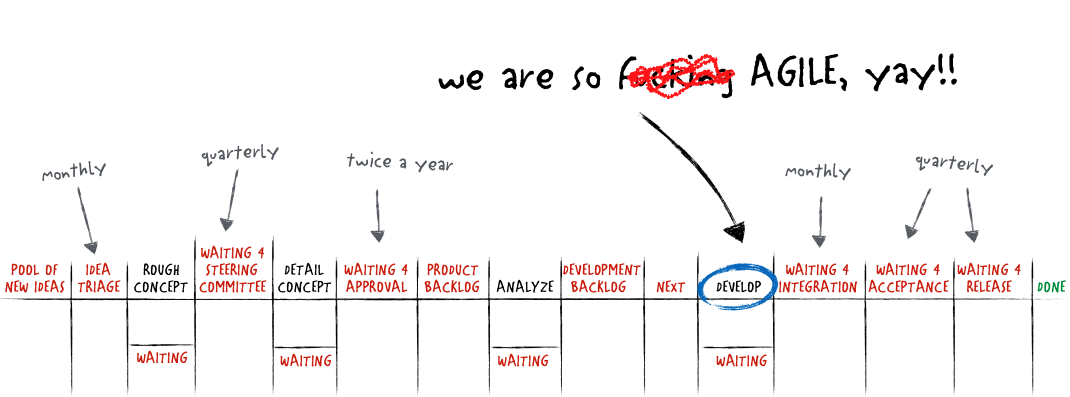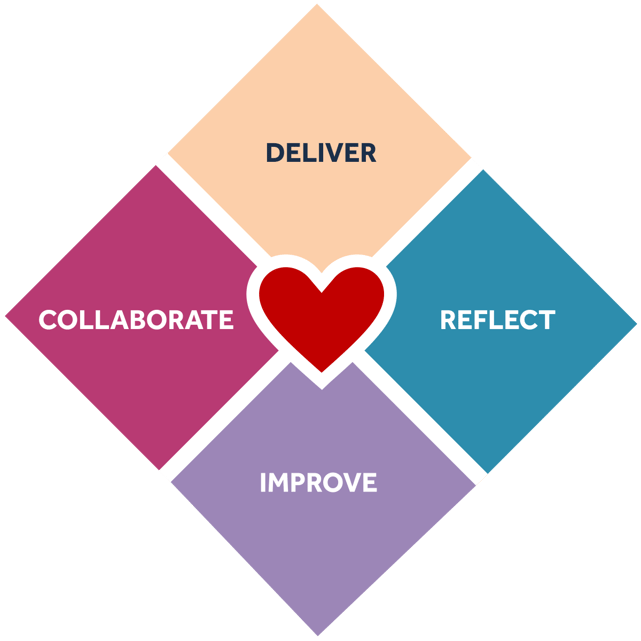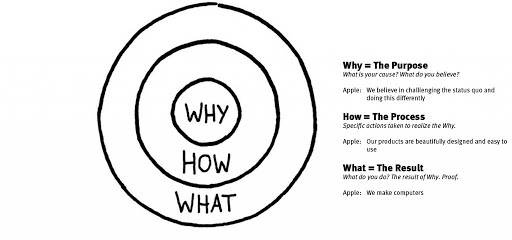In this blog, you'll learn how to use both Heart of Agile and VUCA Prime core values and principles to enable Business Agility. I'll begin by explaining the basics of Business Agility. Next, we'll look at how simple and powerful Heart of Agile is. Then, I'll talk about the VUCA Prime framework and its importance in our current way of life. Finally, you'll see how these three concepts are deeply connected when it comes to behaviors, practices, and tools.
Before we start, a disclaimer: I write based on what I've learned and lived; therefore, it's my point of view. Feel free to disagree, and we can have a great discussion.
The Basics of Business Agility
Both Scrum.org and AgileBusiness.org define Business Agility as the ability of an organization to adapt itself quickly. This adaptation may mean transforming traditional, functional, internal silos with too much power at the top of the pyramid into internal end-to-end value delivery teams with a flat hierarchy and high level of collaboration. It also may encompass responding rapidly to market changes and customer needs without compromising the quality of a product or service. Hence, whether internal or external, Agility enables a business to survive and thrive.
Another exciting and critical approach comes from Dr. Klaus Leopold, a respected computer scientist and Kanban pioneer. He states that "Business Agility is not about having many agile teams, but about having agile interactions connecting them." This approach warns us to pay more attention to the means instead of only transforming the parts.

Why Agile Teams Have Nothing to Do with Business Agility. Image courtesy of InfoQ.
Why is it necessary to enable Agility in businesses?
Why have we talked so much about transformation in recent years? Why do we need to change, to innovate, to disrupt? Why are we continually seeking these things? The answer is simple: changing and adapting is a matter of organizational, professional, and personal survival. If we are not trying to find a way to "kill" our current way of thinking, working, and solving problems, we can be sure that there is someone else doing it for us.
The challenge is all about delivering more value to our customers and being able to do this in a fast, flexible, collaborative, viable, profitable, friendly way. Acting this way should grant a company good outcomes, satisfied customers, and happy employees!
So, now that we know the basics of Business Agility and why it's crucial to practice in our teams and companies, we can begin exploring how to practice it.
Heart of Agile: Simple and Powerful
Dr. Alistair Cockburn, one of the signatories of the Manifesto for Agile Software Development (a.k.a. the Agile Manifesto), came up with what he called a reminder of what's essential. This is called Heart of Agile. Heart of Agile is a group of four words around a heart, and this image represents a radically simpler approach to achieving outstanding outcomes, not only in the software development process, but in every area.
 Image Courtesy of Heart of Agile
Image Courtesy of Heart of Agile
Master the Basics
If you do only these four things (Collaborate, Deliver, Reflect, Improve) over and over, you should see a positive evolution in your work and your deliveries because you're doing the essential, practicing, and mastering the basics of Agility.
However, despite having only four words that are as simple and direct as they seem, Heart of Agile also gives you the freedom to expand on these concepts. From this starting point, there are many powerful ways to implement Business Agility.
VUCA Prime (but first, let me tell you a story...)
Have you heard of General Stanley McChrystal? He is a retired military general and author/co-author of several books, including Team of Teams: New Rules of Engagement for a Complex World. While fighting in a war, General McChrystal realized that his troops could not compete against a network of small cells that attacked quickly and unexpectedly and then hid. Although his troops were more massive, they operated under an extremely vertical structure that did not allow them to act as flexibly or as fast.
The General then broke a big paradigm and began to transform the structure of the troops under his command into a team network that combined:
- Transparency;
- Continuous flow of communication;
- Autonomy;
- Trust for decision making.
The silos were torn down. Team best practices were analyzed and quickly disseminated to the rest of the teams. The change in the organizational model - from vertical, inflexible, and decision-making in the hands of a few - to a "team of teams" was the key to their success. The image below gives us a good idea of what they did:
 From a command structure to a team of teams structure. Image courtesy of Medium.
From a command structure to a team of teams structure. Image courtesy of Medium.
Here Comes the VUCA World
General McChrystal had to do what he did because he was in a VUCA scenario. VUCA is an acronym first used more than 30 years ago to describe the world's new behavior at the time. In the late 1990s, it began to be more discussed, mainly in relation to military education. VUCA stands for Volatility, Uncertainty, Complexity, and Ambiguity. Let's examine each of these in depth:
Volatility
The amount and speed of changes nowadays make it very difficult to predict scenarios as we did before. However, these occurrences are not necessarily hard to understand (knowledge about it is often available). The main problem here is the lack of stability and the sudden turn of events.
Uncertainty
Low understanding of issues and events due to insufficient information; this results in a lack of predictability.
Complexity
The issue or event has many interconnected pieces (e.g., high coupling in software engineering). Information is partially available or predictable, but the volume or nature of it can be overwhelming to process.
Ambiguity
Uncertainty connotes a lack of predictability because there's not enough information. With Ambiguity, on the other hand, you can have enough information, but the causal relationships connecting information are entirely unclear. There's a lack of understanding of precisely what the situation is.
Despite the fact that VUCA has been around a long time, this is still our reality. We try to keep up with scenarios and problems that change all the time; we find multiple causes for our problems, instead of one single root cause; and we make decisions that always come with some level of trade-off, which often leaves us to choose the one with the least impact on our projects or businesses. It is almost as if we are sailing in rough seas without clear directions and with minimum help from navigational devices. We always want to get to a safe port or beach (a.k.a. solving problems), but we also want to do this in the best way possible.
 VUCA Prime framework. Image courtesy of Slide Model.
VUCA Prime framework. Image courtesy of Slide Model.
With that in mind, Bob Johansen, former president of the Institute For The Future (IFTF), released a new concept about this turbulent world. He called it the VUCA Prime Framework . These are the skills/attributes we must develop, incorporate, encourage, and spread to our teams, peers, and leaders so that we can reduce the paralyzing effects of VUCA.
Vision can fight Volatility
When we have a clear purpose and well-defined goals, we know why we are doing something and what are the main criteria for success. Hence, the conditions do not affect us much. We'll probably recover faster and incur less damage than we would if we were clueless about the vision.
Understanding can fight Uncertainty
Everyone should understand the business vision, their role in the team, and their particular contribution to the vision's success. Values, strategies, and metrics should flow dynamically across teams. It is vital to promote constant communication and active listening to give and receive understanding.
Clarity can fight Complexity
We usually get Clarity by making things simple without being simplistic. This involves bringing matters to the surface, understanding them, and prioritizing them. For example, this might mean identifying all the actors involved in a complex situation, their problems and goals, their causal relationships (if any), and so forth.
Agility can fight Ambiguity
We fight Ambiguity by identifying our assumptions and hypotheses and then validating them. This requires processes that allow us to experiment, fail, learn quickly, build, test, measure, learn again, and improve. So, it's about Agility.
Wrapping Up
So, let's wrap everything up! Here is a list of behaviors, practices, and tools that I consider of great relevance:
- Be honest and transparent all the time, with all people: This is one of the basics. Being fair and square helps you to collaborate better with everyone, deliver better products, reflect on the right things, and improve more quickly;
- Keep communication flowing and its channels open for all: Communication is the mother of all interactions, and we saw earlier that it's what Business Agility is all about, according to Dr. Klaus Leopold. So, don't let internal and external communication fall behind;
- It bothers people sometimes, but always Start with Why: In his book Start with Why, Simon Sinek says people are more inspired by a sense of purpose (Why) than things like "How" and "What." From "Why" come the most powerful attributes for any vision you can build. You can also identify the real root causes of a problem, therefore making a better analysis, prioritization, development, and delivery when searching why people want you to put some random solution into your backlog.
 The Golden Circle using Apple as an example. Image courtesy of Alquimia.
The Golden Circle using Apple as an example. Image courtesy of Alquimia. - Objectives and Key Results (OKRs): You've probably heard of OKRs by now. It's a framework for defining and tracking objectives and their outcomes. In it, we set goals for shorter periods, and Key Results are usually reported weekly, allowing a team to overcome Volatility whenever it shows up;
- Product Vision Statement (PVS): According to ProductPlan.com, "A product vision, or product vision statement, describes the overarching long-term mission of your product. Vision statements are aspirational and communicate concisely where the product hopes to go and what it hopes to achieve in the long term." ProductPlan provides a good template for this:
For [our target customer], who [customer’s need], the [product] is a [product category or description] that [unique benefits and selling points]. - Product Roadmap: The product roadmap is a powerful tool that can be used to show stakeholders and teams the Product Vision in terms of features to be delivered in a timeline. Having a Roadmap helps you to reflect regularly and adapt whenever it's necessary;
- Visualize workflow, and make process policies explicit: These are Kanban principles. You may not even use Kanban, but I suggest you take a quick look at its Principles and Properties, because they are strong allies to Business Agility;
- Blameless Post Incident Reviews (PIRs): PIRs are another great way to practice the "Reflect" and "Improve" values found in the Heart of Agile. PIRs focus on discovering the root causes of a problem (system issues), not who was involved (human error). This correlates with both Understanding/Clarity from VUCA Prime and DevOps culture;
- Metrics and Charts: To "Reflect" and "Improve," there must be visible metrics and charts involved. Track Lead Time, Throughput, CFD, Cycle Time, Mean Time to Detect, Mean Time to Restore, Change Fail Rate or whatever is necessary without being too much. Also, remember to measure outcomes--don't focus only on the output.
Conclusion
As we saw, there are many possibilities and variations for enabling Business Agility. This blog's purpose is to highlight a few of these. Key takeaways: it's crucial to remember that you must seek to master the basics of Agility (Collaborate, Deliver, Reflect, Improve) and always fight VUCA effects (Volatility, Uncertainty, Complexity, Ambiguity) with VUCA Prime (Vision, Understanding, Clarity, Agility).
Author
Eduardo Ribeiro
Eduardo Ribeiro is a Product Owner and an Agile Coach at Avenue Code. He is crazy about customer and user experience, business agility, growth mindset, music and games.




